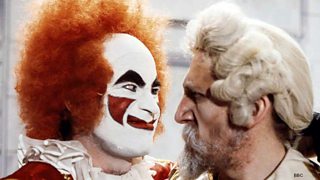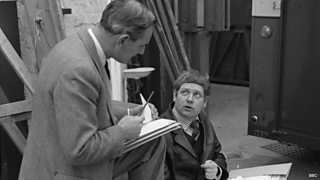
Bob Hoskins played a clown in an edition of Omnibus about the story of pantomime
With the redevelopment work on Television Centre continuing, it reminded me that part of the original building being preserved is the large mosaic mural in the old foyer area, designed by artist John Piper.
Piper had a long career in �������� programming, and as a visual artist perhaps not unsurprisingly he began in television, with a review of work on show in in November 1936.
He continued making appearances pre-war, especially in the series London Galleries, but post war his contributions were more oblique, including providing illustrations and décor, and being interviewed about art, including the profile of him in in 1958. He was also the castaway on Desert Island Discs in 1970, and in 1983 . He died aged 88 in 1992.
Television has naturally always featured the visual arts, and one of the most vaunted examples of its coverage was the landmark series , premiered in 1969, and soon to be remade for the modern era. Hosted by Sir Kenneth Clark, himself a television veteran (including involvement in the beginnings of ITV), the 13-part series was very much the story of Western civilisation, in terms of its art and architecture.
The first of the great authored documentary series, it was also a chance to use the possibilities of colour television when that had only been a reality for a couple of years, though it was still only available to a small number of people due to the expense of colour sets. A kind of companion piece is 1980s, presented by Australian critic Robert Hughes, which gave a modernist perspective. In the meantime there had been the art-philosophical series Ways of Seeing, in which John Berger had presented his own unique take on the visual sphere.
The ��������’s arts coverage had formed a good part of the talks on The Third Programme and Radio 3, but television had the obvious advantage of pictures to help it along. General arts programming perhaps began with, one of a number of programmes created in the wake of when Panorama became solely a current affairs strand.
Huw Wheldon, who has started in the �������� as television publicity officer, after working for the Festival of Britain, was already known from his work on children’s programmes, fronting talent show All Your Own. Monitor, which he edited as well as presented, saw his unique style of presentation come to the fore, his persuasive Welsh tones introducing studio items and films.
This came have the greatest influence, featuring as they did some of the early work of director such as John Schlesinger and Ken Russell. Normally a magazine programme, it occasionally had a single subject, and Russell contributed straight documentaries including , as well as dramatised biographies of Elgar and .

Monitor presenter Huw Wheldon and film director Ken Russell photographed backstage
Wheldon’s talents saw him promoted into �������� management, and towards the end of its run Monitor came under the editorship of Jonathan Miller, whose regime was greeted with less enthusiasm. The series was soon to come to an end.
The Look of the Week was a series presented by Robert Robinson, with a more topical, populist approach, though one edition is enlivened by the music critic Hans Keller having a pained and exasperated discussion of modern musical trends with members of Pink Floyd, his key question amounting to “Why does it have to be so loud?” Well, quite…
In 1967 a better formula was found with the on ��������1. Usually a single-subject filmed series, there was a short period where it became a magazine programme fronted by Barry Norman, but that was not as successful. Its first edition was about the Expo 67 World Fair in Montreal, but it covered music, the visual arts, literature, dance. It also occasionally , for example 1968’s Whistle and I’ll Come to You, an M.R. James ghost story starring Michael Hordern.
The programme had a wide-ranging remit from the popular (Ian Fleming, David Bowie, Morecambe and Wise) to the arcane (and I won’t give the game away by risking to reveal what I think is arcane…). Omnibus had a long and distinguished run, replaced in 2003 by Alan Yentob’s Imagine…
Yentob himself has a long pedigree in arts television, going back at least to ��������2 arts series Review. ��������2 had not needed to have a general arts series while Monitor was still running on ��������1, but in 1965 it started presented by Julian Jebb, and produced by Melvyn Bragg. This was succeeded by Release in 1967 and Review in 1969.
1972 saw ��������2’s arts coverage continue in Full House, hosted by Joe Melia, a live 2-hour marathon which included music, comedy, drama and anything else that occurred to them. The following year, a was Second House, slightly shorter at between 75 and 90 minutes, which tended to have a theme to each edition.
Melvyn Bragg was now presenting, and this continued when the series morphed into The Lively Arts in 1976, which spawned a series of concerts under the banner The Lively Arts In Performance. Bragg eventually left to present The South Bank Show for London Weekend Television, but The Lively Arts staggered on for a few years.
Meanwhile, an alternative ��������2 arts programme had started under the name Arena, which has just marked . Originally alternating editions on Theatre and Art & Design, it added Cinema in its second year, and did occasional editions on other subjects, before dropping the generic subtitles around the turn of the 80s.
Produced by Alan Yentob, the series had a different take on the arts from its ��������1 rival Omnibus, but both continued to provide interesting and original films and features on a broad range of arts topics for several decades.
Andrew Martin will be your regular Sunday guide through the history of broadcasting by digging out archive gems and information from the �������� Genome listings.
